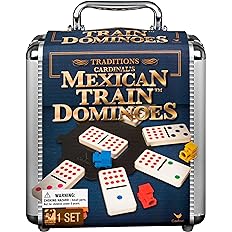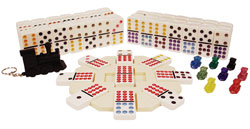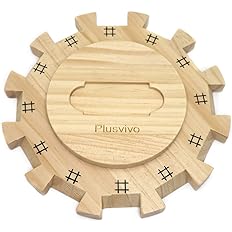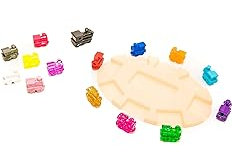Mexican Train
- Introduction
- Equipment and Preparation
- The Play
- The Scoring
- Variations
- Other Mexican Train WWW Pages
- Mexican Train Software
Introduction
Mexican Train is a domino game, played mainly in the USA. It is probably best for four or more players.
Equipment and Preparation
A double twelve set of dominoes is used. This contains all possible pairs of numbers from 0 (blank) to 12, giving 91 pieces in all. In addition some markers are required. Traditionally, coins were used: one penny for each player and one nickel, but some players nowadays use markers representing locomotives.
The dominoes are shuffled and each player takes a number of dominoes and stands them on edge so that their faces are visible to the owner but not to the other players. Up to 4 players take 15 dominoes each, 5 or 6 take 12 each, 7 or 8 take 10 each, and 9 or 10 players take 8 each. The remaining dominoes are left face down in the boneyard.
The Play
First turn
The player who has the 12-12 begins the first game by placing it in the centre of the table. The second game will be started by the 11-11 and so on downwards to the double blank for the 13th game. If no one has the double required to start, players draw equally from the boneyard until it is found.
Note: Since the process for finding the required double can be tedious, you may prefer to place the required double face up on the table before shuffling. In this case players take turns to start.
Beginning with the player who placed the starting double, and continuing in clockwise order around the table, each player now starts to build a train, which is a single row of dominoes starting from the double in the centre and extending towards the player. The ends of adjacent dominoes must match in number and the centre facing end of the first domino played must match the centre domino (in the first game, therefore, a 12 is needed). A single train might look like this:
In this first turn only, the player may play as many dominoes as they wish, so long as they form a valid train.
If any player ends the train they form in their first turn with a double, this has no effect on the game until everyone has played their first turn. When the first player takes their second turn, they will have to satisfy the first exposed double, as explained under doubles.
If any player is unable to start their train - having no domino that matches the centre double - they do not draw from the boneyard. They must simply place a marker (penny) in the position where their train would have started. This indicates that, starting with the first player's second turn, any player will be allowed to play a domino in this position, to start the train. Note, however, that no player is allowed to play on another player's train, nor to start the "Mexican train", during their first turn.
It may sometimes happen that a player is able to play all his or her tiles on the first turn. In this case the game does not end immediately, but continues until all players have played their first turn. After that the scores are counted.
Subsequent turns
After everyone has had one turn, in which they started their train if possible, the rules of play change. Now, each player plays just one domino per turn (unless that domino is a double - see below). This domino may normally be played either
- on the player's own train, or
- on another player's train, if that train is marked with a penny, to show that its owner was unable to play on it at their last move, or
- on an extra train, known as the Mexican Train or Caboose, which is always open to all players.
Of course, each domino must be played in such a way that its inward end matches the open end of the domino it touches.
The Mexican Train or Caboose can be started by any player from the second turn onwards, beginning with a single domino which matches the starting double at one end. The nickel is placed on it, to distinguish it from the other trains and show that it is open to all players. The whole layout, with four players' trains and a Mexican train, might look something like this:
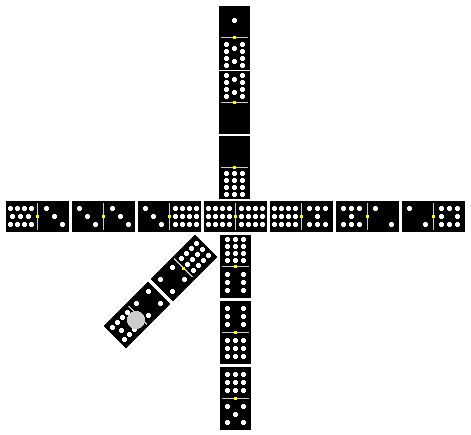
If you find at your turn that none of the ends of your dominoes matches the free ends of the layout on which you are allowed to play, you must draw one domino from the boneyard, and you may play the domino you drew. If you are still unable to play, you must pass and place a marker (penny) on your train, which indicates that any player is now allowed to add a domino to it, as an alternative to playing on their own train or the Mexican train. If you are unable to play and the boneyard is empty, you simply pass and place a marker on your train. (If there is already a marker on your train you just leave it there.)
You must play a tile at your turn if you are able to. You are not allowed to draw from the boneyard if you had a tile that you could legally play. If you cannot play, but draw a tile that is playable, you must play it.
A player whose train has a marker on it can as usual play either on their own train or on any other train that has a marker. If the owner of a marked train plays on their own train, the marker is removed and other players can no longer add to that train. If the owner of a train with a marker adds a tile to another player's marked train, all markers remain in place.
Note that if you were unable to start your train in your first turn, but in a later turn you draw a domino that enables you to start your train (no one else having started it for you), you only play this one domino in that turn (and remove the marker from your train). Having failed to start your train on your first turn you have lost the opportunity to play a series of connecting dominoes all at once to make a train.
Doubles
From your second turn onwards, whenever you play a double you must play an extra domino, which may go anywhere on the layout where you are allowed to play - not necessarily on the double you just played. If you cannot play a second tile you must draw (if available) and if the drawn tile is not playable you pass and put a penny on your train. If the extra domino you play is a second double, you must play a third domino, which again may go anywhere - on the first or second double you played or elsewhere, and may be a third double - and so on. Your turn ends after you play one domino that is not a double or (being unable to do so) you pass and place your penny on your train. The only exception to this is that if your very last domino is a double you may go out with it: in that case the game ends immediately and is scored.
If a double is played, and the player leaves a train ending in a double, then after the end of that player's turn the next domino added to the layout must be played on a double. This is called "satisfying" the double. This situation arises in several cases:
- the player of a double was unable to play a further tile
- the player of a double played the second tile on a different train
- a player plays more than one double (and having only one free turn cannot satisfy more than one of them)
The duty of satisfying the double falls first on the next player after the person who played the double. If they can satisfy the double they must do so - even though it may be in a private train where they could not normally have played. If they cannot satisfy the double from hand, they draw a tile and if that does not match the double either, they pass and place a penny on their own train; the duty of satisfying the double then passes to the following player in turn. If a player leaves several doubles unsatisfied at the end of a turn, each of the exposed doubles must be satisfied by subsequent players in the order that they were played.
If one or more players ends the train they play on their first turn with a double, then these doubles must be satisfied in order as soon as everyone has had their first turn - so beginning with the second turn of the first player.
Note. Some players may prefer to play doubles crosswise on the train (as in other domino games) rather than in line. Whichever way around they are played, doubles in this game do not create a junction where additional tiles can be added as in Chicken Foot. Apart from the starting tile, once a double has two tiles touching it (the tile on which it was played and the tile that satisfies it), no further tiles can be played adjacent to that double.
The Scoring
The play ends as soon as one player runs out of dominoes, or when the layout becomes blocked so that no one can play.
Exception: in the unusual case where someone manages to play all their dominoes at once in their first turn, connecting them all into a train, the play continues until everyone has had their first turn, and then ends.
Each player scores as penalty points the spots on the dominoes they have left (so a player who ran out of dominoes will score no penalty points for that game).
As already explained, a complete session would consist of 13 games, the first started with the 12-12, then the 11-11, 10-10 and so on down to the 0-0. The object is to accumulate as few points as possible over the 13 games - the player with the lowest total score is the winner.
Variations
There are a number of versions of this game, and some of the published descriptions are unfortunately not very clear, making it hard to tell exactly what rules are intended.
There are several variations in the exact circumstances in which markers are placed on personal trains, making them available to be played on than others:
- Some play that the marker is removed as soon as any player (not necessarily the owner) adds to that train. In this version, placing a marker only allows one tile to be added to your train by an opponent, so that you can then continue it.
- Some play that a marker on your train is removed if you manage to play anywhere on the layout. The effect is that, since your train has not been extended since the marker was placed, you are likely still to be unable to play on it, and will probably have to put your marker onto it again in a future turn when you run out of other moves.
- Some play that you do not place a marker on your train if the turn was one in which you were not allowed to play on your train because you had to satisfy a double. The logic here is that you may have been able to play on your train had you been allowed to, so you should not have to open it to other players at this point.
Some do not play the rule that exposed doubles must be satisfied by the next player.
Some play that doubles must be satisfied in the reverse of the order in which they were originally played.
Some do not allow more than one double to be played in the same turn. In this version there can never be more than one unsatisfied double on the table.
Some play the tiles one at a time from the start, rather than each player playing as many tiles as possible on their own train in their first turn.
Some score with positive points instead of penalty points. The player who ran out of dominoes, or the player with fewest points in case of a block, scores the total number of points on the dominoes remaining in the other players' hands. In case of a block with a tie for winner, the winners share the other players' points.
Other Mexican Train WWW Pages
David Bauguess' Mexican Train Rules are based on the Puremco Mexican Train rules, but rewritten for greater clarity and with some suggested improvements. In this version the first turn is not special - right from the start, only one tile per turn is played. The page also includes a useful section on strategy.
The Domino Plaza also has rules for Mexican Train in which the tiles are played one per turn from the start.
Here is Joe Celko's description of Mexican Train; an earlier version of this appeared as the Game Cabinet Mexican Trains page.
Here is Joe Celko's description of Basic Trains, and an earlier version of his Basic Trains page that appeared on Game Cabinet.
At Dasenka design you can buy a range of Mexican Train T-shirts.
Mexican Train Software
From the Amuseware site you can download their Mexican Train for Windows, which can be tried free for a limited time. This program plays the version where the tiles are placed one at a time from the start; you can play with or without the rule that doubles must be satisfied.
Mexican Train Dominoes Gold for iPhone, iPad and for Mexican Train Dominoes Gold for Android are apps in which the user plays against two or three computer opponents with selectable rules for playing doubles.
At mexicantrain.com you can download a free Mexican Train app for iOS, Android or Kindle.
Mexican Train can be played against computer opponents at Online Domino Games.
